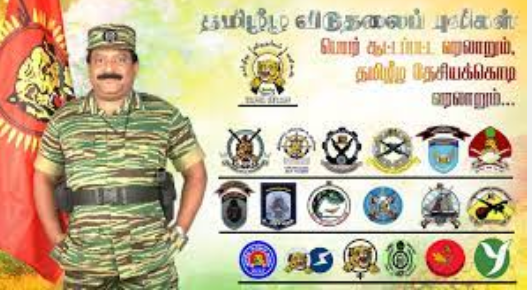Liberation Tigers of Tamil Eelam
The Liberation Tigers of Tamil Eelam (LTTE), also known as the Tamil Tigers, was a separatist militant organization based in northern Sri Lanka. Founded in 1976 by Velupillai Prabhakaran, the LTTE fought for an independent state for the Tamil people in Sri Lanka, known as Tamil Eelam. The group was involved in a prolonged civil war with the Sri Lankan government from 1983 to 2009, resulting in the deaths of an estimated 80,000-100,000 people and the displacement of hundreds of thousands more.
Origins and Ideology
The LTTE emerged as a response to the marginalization and discrimination faced by the Tamil minority in Sri Lanka following the country’s independence from British rule in 1948. The Tamils, who constitute around 11% of Sri Lanka’s population, have faced issues such as state-sponsored colonization of traditional Tamil lands, disenfranchisement, and violence at the hands of the Sinhalese majority.
The LTTE’s ideology was rooted in Tamil nationalism and the right to self-determination. They sought to establish an independent Tamil state, Tamil Eelam, in the north and east of Sri Lanka, where the majority of the Tamil population resides. The group justified its armed struggle as a means to protect the Tamil people from what they perceived as state oppression and discrimination.
Organizational Structure and Leadership
The LTTE was known for its highly disciplined and hierarchical structure, with a centralized leadership under its founder and supreme leader, Velupillai Prabhakaran. Prabhakaran exercised tight control over the organization and was known for his ruthlessness in dealing with dissent within the ranks.
The group had several specialized wings, including:
- Military wing: Responsible for armed combat and guerrilla warfare.
- Intelligence wing: Gathered intelligence and carried out espionage activities.
- Political wing: Managed diplomatic relations and propaganda.
- Sea Tigers: The naval wing of the LTTE, known for its maritime attacks.
- Air Tigers: The air wing of the LTTE, which carried out a few air attacks in the later stages of the conflict.
- Black Tigers: The elite suicide squad of the LTTE, responsible for numerous high-profile attacks.
Women played a significant role in the LTTE, with an estimated one-third of its cadres being female. The group had a dedicated women’s wing, the Women’s Front of the Liberation Tigers, which participated in combat and other roles within the organization.
Tactics and Weapons
The LTTE employed various tactics in its fight against the Sri Lankan government, ranging from guerrilla warfare and conventional military operations to urban terrorism and political assassinations. The group was notorious for its use of suicide bombers, known as “Black Tigers,” who carried out numerous attacks on military, political, and civilian targets.
The LTTE acquired weapons through various means, including arms smuggling, capture of government weapons, and in the early stages of the conflict, support from the Indian government. The group possessed a wide array of weaponry, including small arms, artillery, mortars, and even a limited number of light aircraft and rudimentary naval craft.
Notable Attacks and Assassinations
Throughout the civil war, the LTTE carried out numerous high-profile attacks and assassinations, some of which had far-reaching consequences. Notable incidents include:
- Central Bank bombing (1996): A truck bomb exploded outside the Central Bank in Colombo, killing 91 people and injuring over 1,400.
- Temple of the Tooth attack (1998): LTTE cadres attacked the Temple of the Tooth in Kandy, one of the holiest Buddhist shrines in Sri Lanka, killing 17 people.
- Assassination of Rajiv Gandhi (1991): Former Indian Prime Minister Rajiv Gandhi was assassinated by an LTTE suicide bomber during an election campaign in Tamil Nadu, India. This assassination led to the Indian government’s withdrawal of support for the LTTE.
- Assassination of Ranasinghe Premadasa (1993): Sri Lankan President Ranasinghe Premadasa was killed by an LTTE suicide bomber during a May Day rally in Colombo.
- Assassination of Lakshman Kadirgamar (2005): Sri Lankan Foreign Minister Lakshman Kadirgamar, a prominent Tamil politician and critic of the LTTE, was assassinated by an LTTE sniper at his residence in Colombo.
International Support and Proscription
In the early stages of the conflict, the LTTE received support from the Indian government, particularly under Prime Minister Indira Gandhi. India provided training, weapons, and sanctuary to LTTE cadres in the 1980s. However, following the assassination of Rajiv Gandhi in 1991, India withdrew its support and became actively involved in counterinsurgency efforts against the LTTE.
End of the Civil War
The Sri Lankan military launched a massive offensive against the LTTE in 2006, gradually regaining control of the territories held by the group. The LTTE suffered heavy losses, and its leadership, including Velupillai Prabhakaran, was killed in the final stages of the conflict in May 2009. The Sri Lankan government declared victory over the LTTE, effectively ending the 26-year-long civil war.


